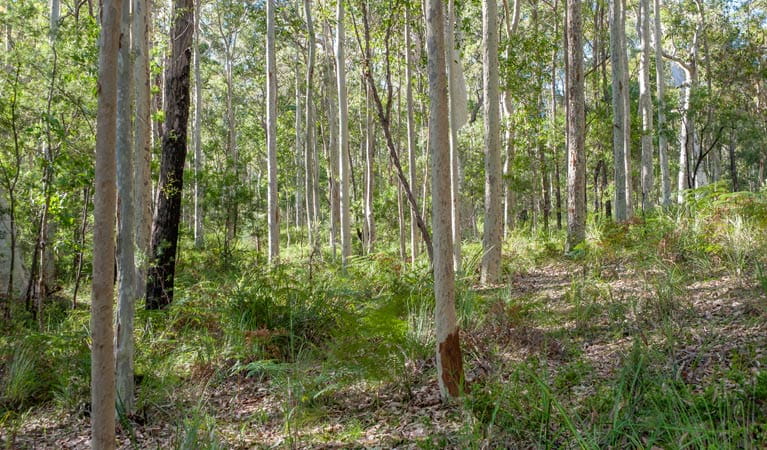Corramy Regional Park
Overview
Corramy Regional Park protects several threatened species while offering visitors a natural playground, with everything on offer from picnicking and walking to kayaking.
Read more about Corramy Regional Park
Created in 2010, Corramy Regional Park offers visitors a natural playground in a tidy package of 292ha. Not far from suburbia, it protects several species of threatened trees and plays host to endangered birds like the glossy black cockatoo. There’s scenic swamp oak forest and a variety of eucalypts, spilling shade over attractive clearings tailor-made for picnicking.
Indeed, Corramy manages to protect our natural diversity while offering compelling reasons to bring the whole family. Pack a lunch and visit for a lazy afternoon, or bring the kayak and make a day of it. Proving size isn’t everything, this small park packs some big opportunities, whether your preference is fishing, walking, or watersports. Along with stunning bushland, there’s Wandandian Creek and the quiet shoreline of St Georges Basin.
Corramy is largely a local haunt, with people from the villages between Nowra and Ulladulla making the most of their weekends in this natural gem. But anybody is welcome, and one visit is all it takes to have you coming back again and again.
Local alerts
For the latest updates on fires, closures and other alerts in this area, see https://www.nationalparks.nsw.gov.au/visit-a-park/parks/corramy-regional-park/local-alerts
Map
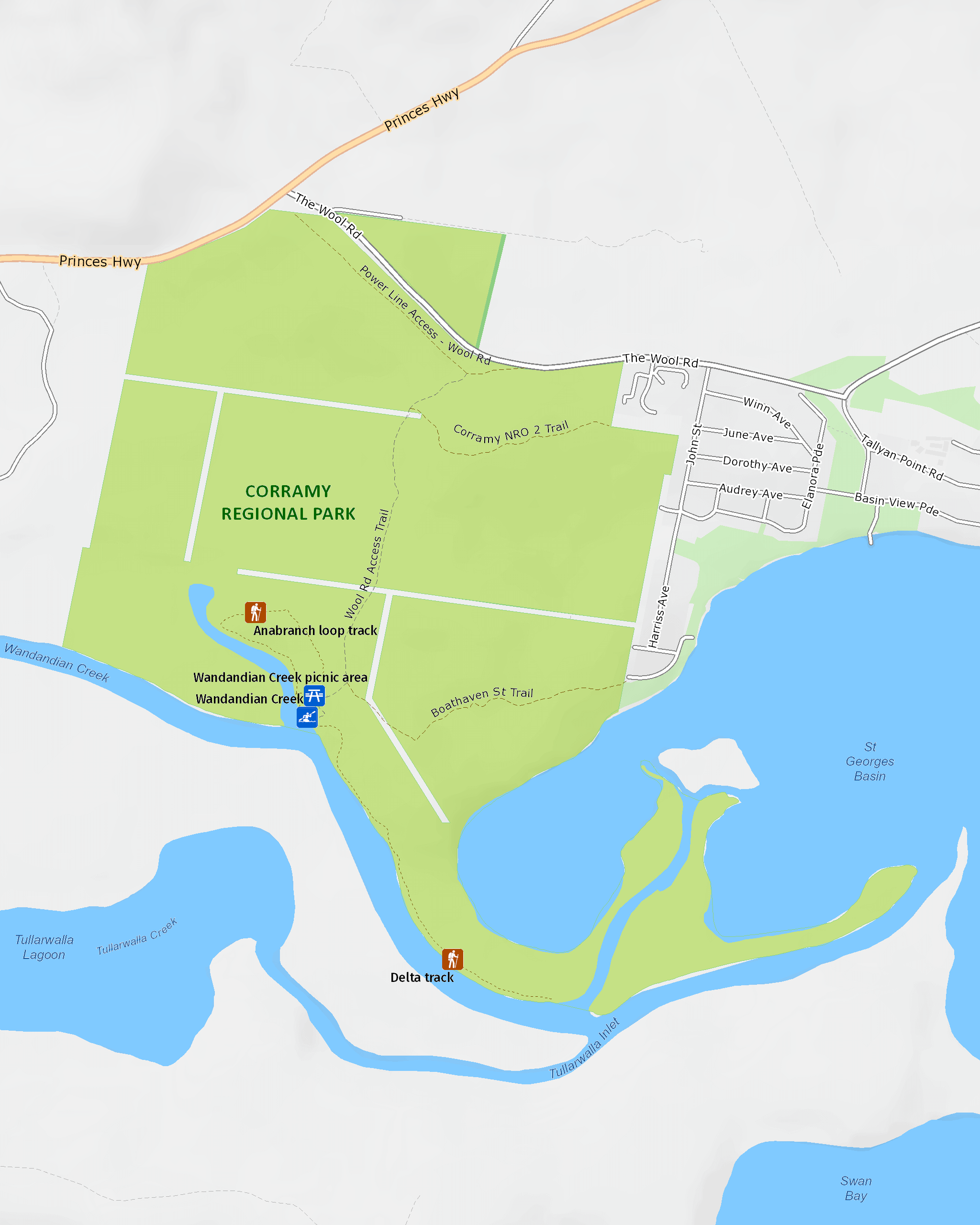
Map legend

Contact
- in the South Coast region
Corramy Regional Park is always open but may have to close at times due to poor weather or fire danger.
-
-
Nowra office
02 4428 6300
Contact hours: Monday to Friday, 9am to 4pm. - 104 Flatrock Road, Mundamia NSW 2540
-
Email: npws.shoalhaven@environment.nsw.gov.au
-
Nowra office
Visitor info
All the practical information you need to know about Corramy Regional Park.
Getting there and parking
Get driving directions
From Nowra:
- Travel south along Princes Highway
- Turn left (east) into The Wool Road, just north of Bewong.
- Turn right (south) after approximately 1km to enter Corramy Regional Park
Parking
- Wandandian Creek picnic area See on map
By bike
Check out the Bicycle information for NSW website for more information.
By public transport
Corramy Regional Park is not accessible by public transport.
Best times to visit
There are lots of great things waiting for you in Corramy Regional Park. Here are some of the highlights.
Autumn
Venture out on Wandandian Creek in a kayak, heading out to St Georges Basin or downstream to connect with Tullarwalla Lagoon.
Spring
Take a stroll along Anabranch Branch and admire the blooming wildflowers beneath the eucalypts.
Summer
Escape the summer heat with a cool lunch at Wandandian Creek picnic area.
Weather, temperature and rainfall
Summer temperature
Average
16.1°C and 22.6°C
Highest recorded
40.6°C
Winter temperature
Average
9.7°C and 15.7°C
Lowest recorded
-3.2°C
Rainfall
Wettest month
May
Driest month
September
The area’s highest recorded rainfall in one day
316.7mm
Facilities
Picnic tables
Maps and downloads
Prohibited
Pets
Pets and domestic animals (other than certified assistance animals) are not permitted. Find out which regional parks allow dog walking and see the pets in parks policy for more information.
Smoking
NSW national parks are no smoking areas.
Nearby towns
St Georges Basin (5 km)
St Georges Basin is a large, shallow lagoon with outstanding boating and fishing. The town is a tree-lined waterway ringed by villages and forests.
Nowra (27 km)
Nowra is a historic city and the commercial heart of the Shoalhaven. It's on the Shoalhaven River close to beaches and national parks.
Ulladulla (40 km)
Ulladulla is close to several wonderful national parks. Morton National Park, to the west, is home to Pigeon House Mountain, a local landmark which is a popular climb. Murramarang National Park, between Ulladulla and Batemans Bay, has beautiful coastal walks, beaches and camping sites.
Learn more
Corramy Regional Park is a special place. Here are just some of the reasons why:
Preserving our threatened species
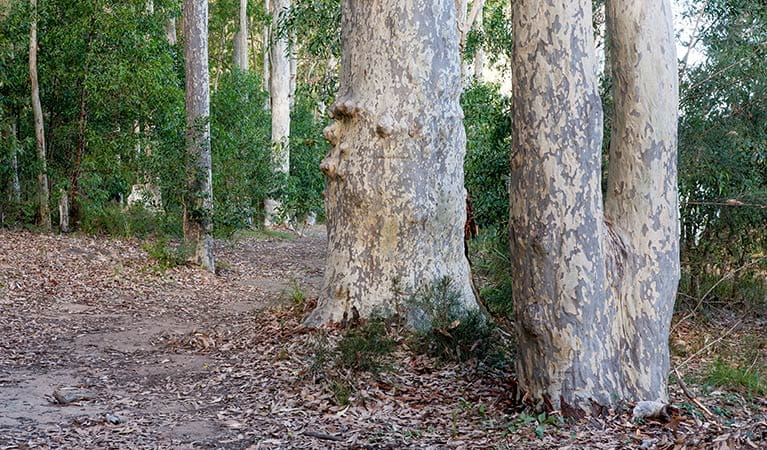
Corramy Regional Park may be just down the road from several small townships, but it plays a critical role in preserving natural diversity. There are two endangered ecological communities in the park: swamp oak floodplain forest, growing along the foreshore of Wandandian Creek; and river-flat eucalypt forest with stands of red gum. Strolling in the regional park is to stroll through a precious reserve of these trees. Corramy is also home to threatened animals, with yellow-bellied gliders and glossy black cockatoos recorded in the area. Take a camera and keep your eyes peeled, but be careful not to disturb their habitat.
- Delta track The longer of the two walks near Wandandian Creek, near Nowra, Delta track follows the foreshore for 1.5km, crossing two beaches with opportunities for fishing and birdwatching.
Aboriginal heritage
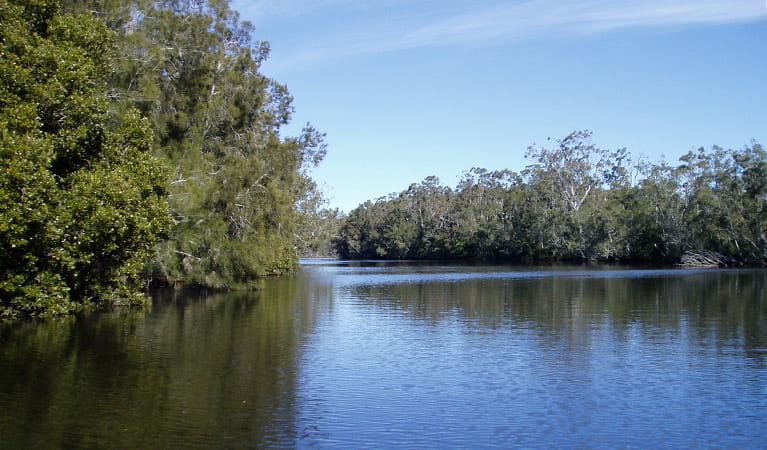
'Corramy' is the Aboriginal name for the local area. Because of its diverse environments, the area provided a variety of resources for Aboriginal people.
A natural playground
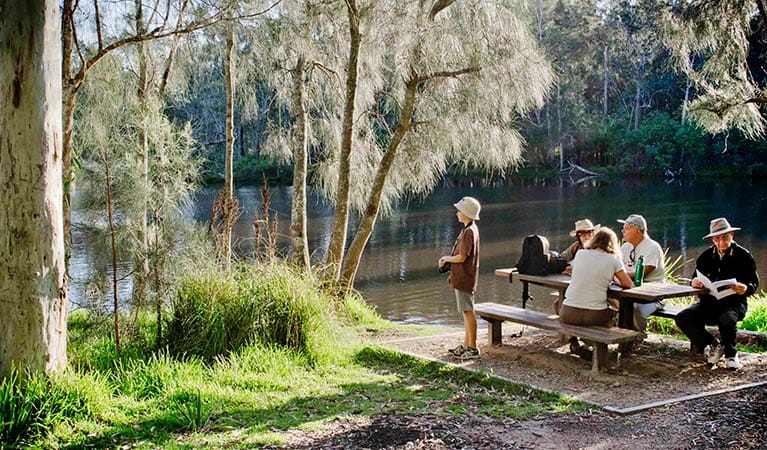
Even as it preserves important species of plants and animals, Corramy Regional Park offers terrific recreation opportunities in easy reach of towns between Nowra and Ulladulla. Within or around the park, visitors can enjoy cycling, horse riding, picnicking, fishing or kayaking on the foreshores and waterways like St Georges Basin.
- Wandandian Creek Wandandian Creek is an easily accessible waterway that offers several branching directions for a variety of activities including paddling, fishing, kayaking and birdwatching.
Plants and animals protected in this park
Animals
-
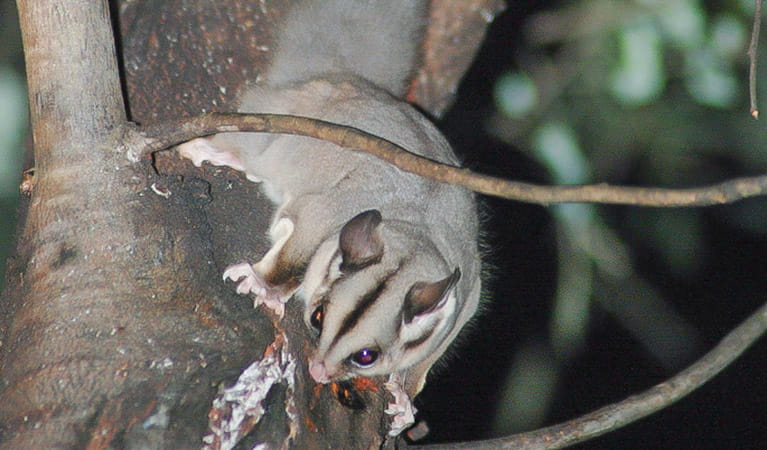
Sugar glider (Petaurus breviceps)
The sugar glider is a tree-dwelling Australian native marsupial, found in tall eucalypt forests and woodlands along eastern NSW. The nocturnal sugar glider feeds on insects and birds, and satisfies its sweet tooth with nectar and pollens.
-

Southern boobook (Ninox novaeseelandiae)
The southern boobook, also known as the mopoke, is the smallest and most common native owl in Australia. With a musical 'boo-book' call that echoes through forests and woodlands, the southern boobook is a great one to look out for while bird watching.
-
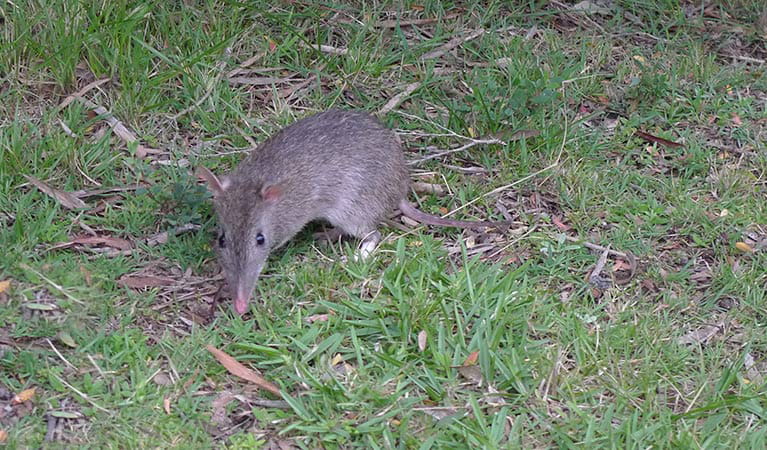
Long-nosed bandicoot (Perameles nasuta)
A nocturnal marsupial and one of the smaller Australian native animals, the long-nosed bandicoot is found across eastern Australia. Populations in the Sydney region have dwindled since European settlement, leaving only endangered colonies in inner western Sydney and at North Head, near Manly. The long-nosed bandicoot has grey-brown fur and a pointed snout which it uses to forage for worms and insects.
Plants
-
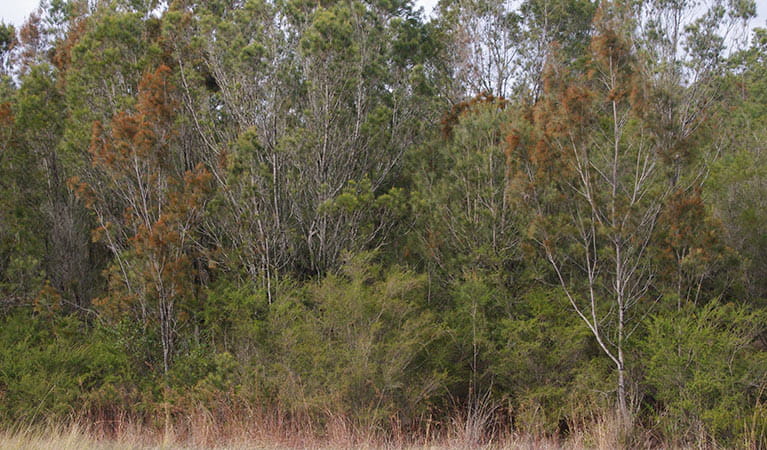
Black sheoak (Allocasuarina littoralis)
The black sheoak is one of a number of casuarina species found across the east coast of Australia and nearby tablelands. Growing to a height of 5-15m, these hardy Australian native plants can survive in poor or sandy soils. The barrel-shaped cone of the black sheoak grows to 10-30mm long.
Environments in this park
Education resources (1)
What we're doing
Corramy Regional Park has management strategies in place to protect and conserve the values of this park. Visit the OEH website for detailed park and fire management documents. Here is just some of the work we’re doing to conserve these values:
Understanding landscapes and geology
Corramy Regional Park boasts a wealth of beautiful scenery, and the park is committed to protecting and preservating such landscapes. Programs to protect and preserve its waterways, wetlands, bushland and unique ecosystems are in place within the park, and operate with minimal disruption to the visitor experience. Where necessary, NPWS liaises with park neighbours and authorities on park conservation issues.
Preserving biodiversity
Corramy Regional Park supports the biodiversity of its plant life and wildlife. Restoration, conservation and bush regeneration activities are regularly carried out within this park and programs to protect and recover endangered ecological communities and threatened plant and animal species are widespread and ongoing. Targeted surveying takes place in this park, and NPWS engages in community and council liaison where necessary.
Managing weeds, pest animals and other threats
Pests and weeds have a significant impact to the ecosystems within Corramy Regional Park. Risk assessments for new and emerging weeds are carried out as an ongoing initiative within the park. Pest management is an important part of the work NPWS does to protect the integrity of biodiversity which exists within Corramy.
Developing visitor facilities and experiences
NPWS strives to raise awareness of Corramy Regional Park's natural values and the need to protect them. The park encourages informed, sustainable visitor access through the provision of interpretive signage and other educational means, and NPWS works with the community in promoting, interpreting and getting involved with the park and its assets.
Managing fire
NSW is one of the most bushfire prone areas in the world as a result of our climate, weather systems, vegetation and the rugged terrain. NPWS is committed to maintaining natural and cultural heritage values and minimising the likelihood and impact of bushfires via a strategic program of fire research, fire planning, hazard reduction, highly trained rapid response firefighting crews and community alerts.

